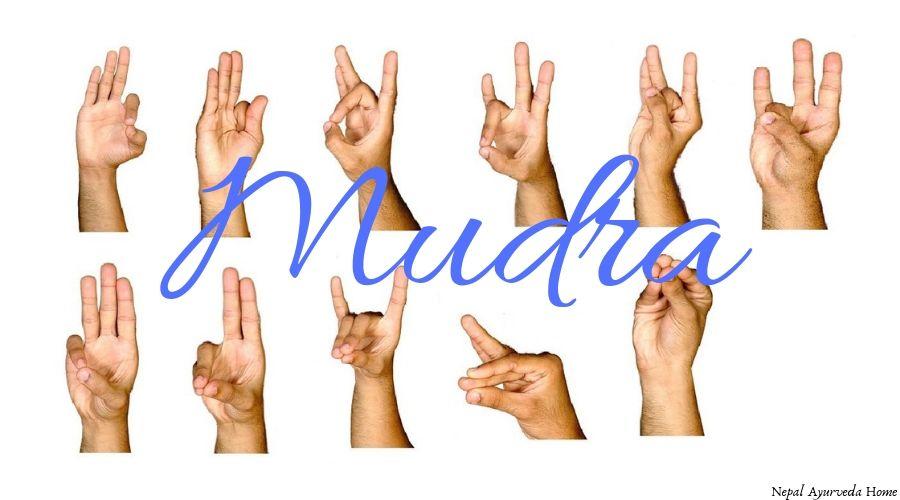Mudra is a Sanskrit word which literary means “seal”, “mark”, or “gesture”. A Mudrā is a psychological as well as spiritual gesture performed with a physical body that requires an energetic seal of authenticity applied in the iconography and spiritual practice. Mudra is also known as aesthetic gestures or attitudes, psychic, devotional, emotional state. Mudra is found to be a link of energy flow of individual pranic force with the cosmic source of energy. Mudra is followed by different tradition like Tibetan, Jain, Hindu and Buddhist. Some mudras are performed with the entire body, while most of the mudras involve hands and fingers.
The meaning of Mudra in Kularnava Tantra is stated as root ‘mud’ meaning pleasure or delight, and ‘Dravay’ means a topical form of dru i.e. “to draw forth”. Mudras are linked with subtle physical movements which can change mood, perception, and attitude. Mudras are very effective to deepen concentration and awareness. A mudra can be a simple hand position or it also may involve entire body combining with asana, pranayama, banda and imagination technique.
In yoga asana practice (hatha yoga), mudras are used in asana, conjunction with pranayama (yogic breathing) as well as in dhyana (meditation). While in seated asanas (postures), mudra stimulates different parts of the body connected with breathing and influence the flow of Prana (life force), Bindu (male psycho-sexual energy), bodhicitta (consciousness), Amrita (immortality). Generally, Hatha yogic mudras are internal activities of the pelvic floor, genitals, anus, abdomen, diaphragm, throat, eyes, tongue and other parts of the body. Mula Bandha, Vajroli Mudra, Viparita Karani, Mahamudra, and Khechari Mudra are examples of this diversity of mudras. They are also referred to as yoga mudras.
How Yogic Mudra Works
Yogic Mudra changes energy flow like that of acupressure and acupuncture. All acupuncture meridians either start or cease in the hand or feet. When the position hands and fingers are changed into a mudra, prana will also be changed in the body. It rewires subtle energy vibration. For example, thumbs activate the lung meridian, middle fingers activate circulation sex meridian, ring fingers activate your triple warmer meridian, little fingers activate both the small intestine and heart meridians. Your pointer fingers activate your large intestine meridian.
Besides, mudras make a balance among the five elements- fire, air, sky, earth, and water in the human body. Each of the fingers is linked with a form of energy. The thumb is connected with fire energy and it activates the fire energy. Similarly, index fingers activate air, middle fingers activate sky (space), ring fingers activate earth energy and little fingers activate water energy.
When the palms are faced upwards, more prana (energy) tends to come from the universe. When you face your palms down, it allows you to stay aware of prana flow. Among the seven bodies of human the second body etheric body or energy body is called known as Pranamaya Kosh in yoga, controls the physical body. Every pain and pleasure, disease and health begin from the etheric body. In other words, every illness arises due to unbalanced energy in the Pranamaya kosha. The Pranamaya kosha includes your acupuncture meridians, the chakras, and breath. Thus, yoga mudras are powerful tools for healing. It is ideal to use these free of cost, simple, drug-free natural healing strategies to bring balance on prana and enhance the situation.
You can balance and keep in harmony entire mind-body system keeping your acupuncture meridians and five elements into perfect alignment, thereby exploring your natural health and rejuvenating your entire being. With the practice of mudra, you can open yourself to a greater and deeper level of prana and purify yourself naturally from all the ailments the inside out.
Different Types Of Mudras
There are some common mudras that the majority of Buddhist practices. These mudras are practised in Hinduism and in other sects as well. They are
- Jnana Mudra
- Dhyana Mudra
- Abhaya Mudra
- Karana Mudra
- Bodhyangi Mudra
- Bhumisparsa Mudra
- Dhammachakra Mudra
- Vajra Mudra
- Varada Mudra
- Vitarka Mudra
Hasta Mudra is used in Nepali and Indian classical dance as well. Twenty four mudras are described in Natya Shastra, and the Abhinaya Darpana of Nandikeshvara describes 28 Mudras. In all the forms of Nepali and Indian classical dance, the mudras are similar or same, though the names and uses vary. There are 24 root mudras in Kathakali, 32 root mudras in Bharatanatyam, and 20 in Odissi. These root mudras are combined in multiple ways, such as one hand, two hands, arm movements, body gesture and facial expressions.
Satyananda Saraswati Categorized Mudra In Five Groups(Yoga):
1. Hasta (Hand) Mudras
The Hand Mudras redirect pranic force chucked out the hands back into the body. Each of the fingers has special effects on the body. Example of Hasta Mudras are- Jnana Mudra, Dhyana Mudra, Hridaya Mudra, etc.
2. Mana (Head) Mudras:
Mana Mudras are an integral part of Kundalini yoga. Each of this category of mudra requires meditation. Examples- Shambhavi Mudra, Khechari Mudra, Shanmukhi Mudra etc.
3. Kaya (Postural) Mudras
Kaya Mudras involve physical postures with the proper linkage of breathing and concentration. Examples- Viparita Karani Mudra, Yoga Mudra, etc.
4. Bandha (Lock) Mudras
Both Mudra and Bandha are combined in this type of Mudras. These practices recharge the prana to prepare for Kundalini activation. Examples- Maha Mudra, Maha Bheda Mudra, etc.
5. Adhara (Perineal) Mudras
Perennial Mudras are very important to flow the energy from the root level to the brain. The basic and fundamental energy is involved with this practice. Ashwini Mudra and Vajroli Mudra are examples of Adhara Mudras.
